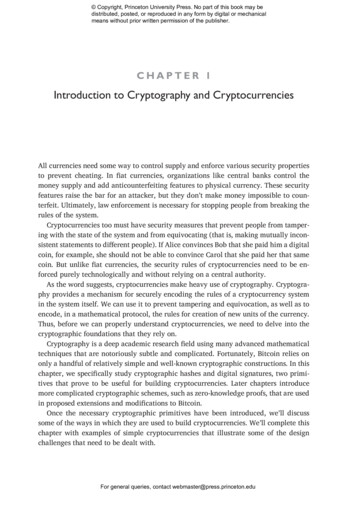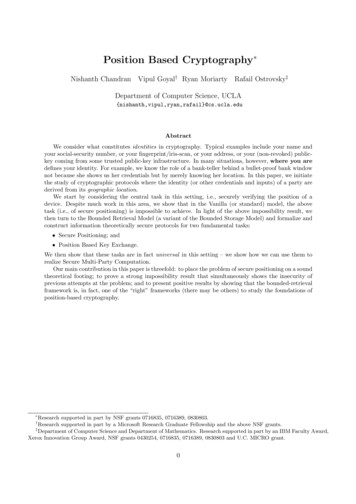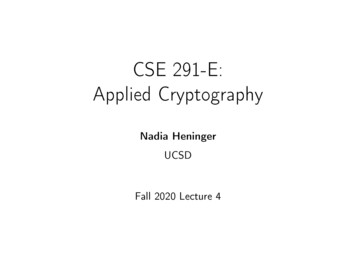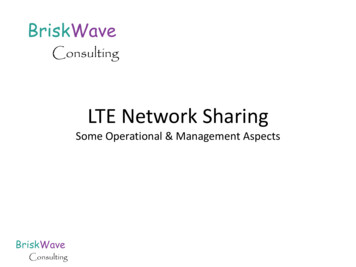
Transcription
Introduction to CryptographyByMarcus K. G. AdomeyChief Operations ManagerAfricaCERTEmail: marcus.adomey@africacert.org
OVERVIEW Cryptography Definition Terminology History Goal and Services Types of Cryptography Symmetric Key Cryptography Asymmetric Key Cryptography Hash Functions
CRYPTOGRAPHY Definition Terminology History Goal and Services
CryptographyDefinitionCryptography is the science of using mathematics to encrypt and decrypt data.Phil ZimmermannCryptography is the art and science of keeping messages secure.Bruce SchneierThe art and science of concealing the messages to introduce secrecy in informationsecurity is recognized as cryptography.
CryptographyTerminologiesA message is plaintext (sometimes called cleartext). The process of disguising a message in such away as to hide its substance is encryption. An encrypted message is ciphertext. The process ofturning ciphertext back into plaintext is decryption.A cipher (or cypher) is analgorithm for performingencryption or decryption—aseries of well-defined stepsthat can be followed as aprocedure.
CryptographyTerminologyA cryptosystem is an implementation of cryptographic techniques and their accompanying infrastructure toprovide information security services. A cryptosystem is also referred to as a cipher system. The variouscomponents of a basic cryptosystem are as follows Plaintext Encryption Algorithm Ciphertext Decryption Algorithm Encryption Key Decryption Key
CryptographyTerminologyWhile cryptography is the science of securing data, cryptanalysis is the science of analyzing andbreaking secure communication. Classical cryptanalysis involves an interesting combination ofanalytical reasoning, application of mathematical tools, pattern finding, patience, determination,and luck. Cryptanalysts are also called attackers.Cryptology embraces both cryptography and cryptanalysis.
CryptographyHistory of CryptographyHistory of Cryptography
History of CryptographyAs civilizations evolved, human beings got organized in tribes, groups, and kingdoms.This led to the emergence of ideas such as power, battles, supremacy, and politics.These ideas further fueled the natural need of people to communicate secretly with selective recipient whichin turn ensured the continuous evolution of cryptography as well.The roots of cryptography are found in Roman and Egyptian civilizations.
History of CryptographyHieroglyphThe first known evidence of cryptography can be traced to the use of ‘hieroglyph’. Some 4000 years ago, theEgyptians used to communicate by messages written in hieroglyph.
History of CryptographyCaesar Shift CipherCaesar Shift Cipher, relies on shifting the letters of a message byan agreed number (three was a common choice), the recipient ofthis message would then shift the letters back by the samenumber and obtain the original message.The Caesar cipher is named after Julius Caesar , who used it witha shift of three to protect messages of military significance.
History of CryptographyCaesar Shift CipherDecryptionEncryptionPLAINTEXT:CYPHERTEXT :internet society ghana chapterlqwhuqhw vrflhwb jkdqd fkdswhu
History of CryptographyKamasutra CipherThe Kamasutra cipher is one of the earliest known substitutionmethods.It is described in the Kamasutra around 400 BC.The purpose was to teach women how to hide secret messagesfrom prying eyes.
History of CryptographyKamasutra CipherThe techniques involves randomly pairing letters of the alphabet, and then substituting eachletter in the original message with its partner.UPPER HALFLOWER HALFWNZHVGPXOKThe key is the permutation of the alphabet.INTERNET SOCIETY GHANA CHAPTERDWRCTWCR FKEDCRL VZJWJ EZJXRCTFSDIECAJBURTMQYL
Goal and Services
CryptographyGoal and ServicesGoal: The primary goal of cryptography is to secure important data on the hard disk oras it passes through a medium that may not be secure itself. Usually, that medium is acomputer network.Services: Cryptography can provide the following services: Confidentiality (secrecy) Integrity (anti-tampering) Authentication Non-repudiation.
Goal and ServicesConfidentiality (secrecy) Ensuring that no one can read the message except the intended receiver Data is kept secret from those without the proper credentials, even ifthat data travels through an insecure mediumIntegrity (anti-tampering) Assuring the receiver that the received message has not been altered inany way from the original.
CryptographyGoal and ServicesAuthenticationCryptography can help establish identity for authentication purposesThe process of proving one's identity. (The primary forms of host-to-hostauthentication on the Internet today are name-based or address-based,both of which are notoriously weak.)Non-repudiationA mechanism to prove that the sender really sent this message
Types of Cryptography Symmetric Key Cryptography Asymmetric Key Cryptography Hash Functions
Types of CryptographySymmetric Key CryptographyAlso known as Secret Key Cryptography or Conventional Cryptography, Symmetric KeyCryptography is an encryption system in which the sender and receiver of a message share asingle, common key that is used to encrypt and decrypt the message.The Algorithm use is also known as a secret key algorithm or sometimes called a symmetricalgorithmA key is a piece of information (a parameter) that determines the functional output of acryptographic algorithm or cipher.
Types of CryptographySymmetric Key CryptographyThe key for encrypting and decrypting the file had to be known to all the recipients. Else, the messagecould not be decrypted by conventional means.
Types of CryptographySymmetric Key Cryptography - ExamplesData Encryption Standard (DES)The Data Encryption Standard was published in 1977 by the US National Bureau of Standards.DES uses a 56 bit key and maps a 64 bit input block of plaintext onto a 64 bit output block of ciphertext. 56bits is a rather small key for today's computing power.Triple DESTriple DES was the answer to many of the shortcomings of DES. Since it is based on the DES algorithm, it isvery easy to modify existing software to use Triple DES. It also has the advantage of proven reliability and alonger key length that eliminates many of the shortcut attacks that can be used to reduce the amount oftime it takes to break DES.
Types of CryptographySymmetric Key Cryptography - ExamplesAdvanced Encryption Standard (AES)(RFC3602)Advanced Encryption Standard (AES) is an encryption standard adopted by the U.S. government. Thestandard comprises three block ciphers, AES-128, AES-192 and AES-256, adopted from a larger collectionoriginally published as Rijndael.Each AES cipher has a 128-bit block size, with key sizes of 128, 192 and 256 bits, respectively. The AESciphers have been analyzed extensively and are now used worldwide, as was the case with itspredecessor, the Data Encryption Standard (DES).
Types of CryptographySymmetric Key CryptographyIDEA:- The International Data Encryption Algorithm was developed in 1991.It uses a 128 bit key to encrypt a 64 bit block of plaintext into a 64 bit block of ciphertext.IDEA's general structure is very similar to DES, it performs 17 rounds, each round taking 64 bits ofinput to produce a 64 bit output, using per-round keys generated from the 128 bit key.
Types of CryptographySymmetric Key Cryptography - wfishSafer-CrabRC5-
Types of CryptographyProblems with Conventional CryptographyKey ManagementSymmetric-key systems are simpler and faster; their main drawback is that the two parties mustsomehow exchange the key in a secure way and keep it secure after that.Key Management caused nightmare for the parties using the symmetric key cryptography. They wereworried about how to get the keys safely and securely across to all users so that the decryption of themessage would be possible. This gave the chance for third parties to intercept the keys in transit todecode the top-secret messages. Thus, if the key was compromised, the entire coding system wascompromised and a “Secret” would no longer remain a “Secret”.This is why the “Public Key Cryptography” came into existence.
Types of CryptographyAsymmetric Key CryptographyAsymmetric cryptography , also known as Public-key cryptography, refers to a cryptographic algorithm whichrequires two separate keys, one of which is private and one of which is public. The public key is used toencrypt the message and the private one is used to decrypt the message.
Types of CryptographyAsymmetric Key CryptographyPublic Key Cryptography is a very advanced form of cryptography.Officially, it was invented by Whitfield Diffie and Martin Hellman in 1975.The basic technique of public key cryptography was first discovered in 1973 by the British Clifford Cocks ofCommunications-Electronics Security Group (CESG) of (Government Communications Headquarters - GCHQ)but this was a secret until 1997.
Types of CryptographyAsymmetric Key Cryptography - ExamplesDigital Signature Standard (DSS)Digital Signature Standard (DSS) is the digital signature algorithm (DSA) developed by the U.S. National SecurityAgency (NSA) to generate a digital signature for the authentication of electronic documents. DSS was put forthby the National Institute of Standards and Technology (NIST) in 1994, and has become the United Statesgovernment standard for authentication of electronic documents. DSS is specified in Federal InformationProcessing Standard (FIPS) 186.
Types of CryptographyAsymmetric Key Cryptography - ExamplesAlgorithm - RSARSA (Rivest, Shamir and Adleman who first publicly described it in 1977) is an algorithm for public-keycryptography. It is the first algorithm known to be suitable for signing as well as encryption, and one ofthe first great advances in public key cryptography.RSA is widely used in electronic commerce protocols, and is believed to be secure given sufficiently longkeys and the use of up-to-date implementations.
Types of CryptographyAsymmetric Key Cryptography - ExamplesRSA CryptanalysisRivest, Shamir, and Adelman placed a challenge in Martin Gardner’s column in Scientific American(journal) in which the readers were invited to crack.C 9,290,026,879,543,541
Types of CryptographyAsymmetric Key Cryptography - ExamplesRSA CryptanalysisThis was solved in April 26, 1994, cracked by an international effort via the internet with the use of 1600workstations, mainframes, and supercomputers attacked the number for eight months before finding itsPublic key and its private key.Encryption key 9007The message "first solver wins one hundred dollars".Of course, the RSA algorithm is safe, as it would be incredibly difficult to gather up such internationalparticipation to commit malicious acts.
Types of CryptographyAsymmetric Key Cryptography - ExamplesElGamal ElGamal is a public key method that is used in both encryption and digital signing. The encryption algorithm is similar in nature to the Diffie-Hellman key agreement protocol It is used in many applications and uses discrete logarithms. ElGamal encryption is used in the free GNU Privacy Guard software
Hash FunctionsWhat is a Hash FunctionA cryptographic hash function is a hash function thattakes an arbitrary block of data and returns a fixed-sizebit string, the cryptographic hash value, such that any(accidental or intentional) change to the data will (withvery high probability) change the hash value. The datato be encoded are often called the message, and thehash value is sometimes called the message digest orsimply digest.
Hash FunctionsWhat is a Hash FunctionThe ideal cryptographic hash function has four main properties: it is easy to compute the hash value for any given message it is infeasible to generate a message that has a given hash it is infeasible to modify a message without changing the hash it is infeasible to find two different messages with the same hash.
Hash FunctionsHash Function - ExamplesSnefruRalph MerkleN-HashNippon T.T.Message Digest MD2(RFC 1115 )B. KaliskiMD4(RFC1320)Ron RivestMD5(RFC 1321)Ron RivestMD6SHA1SHA2
Hash FunctionsCollusion DiscoveryIn March 2005 Xiaoyun Wang and Hongbo Yu ofShandong University in China created a pair offiles that share the same MD5 checksum henceprove that there is a collusion when using MD5
Hash FunctionsBy Xiaoyun Wang and Hongbo YuCollusion Discoveryfile1.dat00000000 d1 31 dd 02 c5 e6 ee c4 69 3d 9a 06 98 af f9 5c00000010 2f ca b5 87 12 46 7e ab 40 04 58 3e b8 fb 7f 8900000020 55 ad 34 06 09 f4 b3 02 83 e4 88 83 25 71 41 5a00000030 08 51 25 e8 f7 cd c9 9f d9 1d bd f2 80 37 3c 5b00000040 96 0b 1d d1 dc 41 7b 9c e4 d8 97 f4 5a 65 55 d500000050 35 73 9a c7 f0 eb fd 0c 30 29 f1 66 d1 09 b1 8f00000060 75 27 7f 79 30 d5 5c eb 22 e8 ad ba 79 cc 15 5c00000070 ed 74 cb dd 5f c5 d3 6d b1 9b 0a d8 35 cc a7 e3file2.dat00000000 d1 31 dd 02 c5 e6 ee c4 69 3d 9a 06 98 af f9 5c00000010 2f ca b5 07 12 46 7e ab 40 04 58 3e b8 fb 7f 8900000020 55 ad 34 06 09 f4 b3 02 83 e4 88 83 25 f1 41 5a00000030 08 51 25 e8 f7 cd c9 9f d9 1d bd 72 80 37 3c 5b00000040 96 0b 1d d1 dc 41 7b 9c e4 d8 97 f4 5a 65 55 d500000050 35 73 9a 47 f0 eb fd 0c 30 29 f1 66 d1 09 b1 8f00000060 75 27 7f 79 30 d5 5c eb 22 e8 ad ba 79 4c 15 5c00000070 ed 74 cb dd 5f c5 d3 6d b1 9b 0a 58 35 cc a7 e3
Hash FunctionsCollusion Discoveryfile1.datfile2.dat00000000 d1 31 dd 02 c5 e6 ee c4 69 3d 9a 06 98 af f9 5c00000010 2f ca b5 87 12 46 7e ab 40 04 58 3e b8 fb 7f 8900000020 55 ad 34 06 09 f4 b3 02 83 e4 88 83 25 71 41 5a00000030 08 51 25 e8 f7 cd c9 9f d9 1d bd f2 80 37 3c 5b00000040 96 0b 1d d1 dc 41 7b 9c e4 d8 97 f4 5a 65 55 d500000050 35 73 9a c7 f0 eb fd 0c 30 29 f1 66 d1 09 b1 8f00000060 75 27 7f 79 30 d5 5c eb 22 e8 ad ba 79 cc 15 5c00000070
Kamasutra Cipher The Kamasutra cipher is one of the earliest known substitution methods. It is described in the Kamasutra around 400 BC. The purpose was to teach women how to hide secret messages from prying eyes. History of Cryptography. Kamasutra Cipher The techniques involves randomly pairing letters of the alphabet, and then substituting each letter in the original message with











